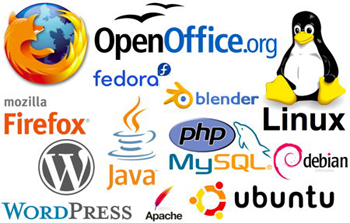Open source solutions are everywhere in today’s world.
Linux continues to grow as an OS alternative to Windows and other platforms, with millions of users. Hadoop developed as an open source solution for storage, and is now contending as a new operating system for the Web.
We can think of open source software as a specific type of crowd sourcing. There’s no denying the power of crowd sourcing to solve many kinds of problems. Wikipedia is a crowd-sourced, modern day version of the Library of Alexandria. Airlines use crowd sourcing (each plane in the air is a data source) to spot bad weather or turbulence and reroute flights. Just a few days ago, it was reported that a new effort to discover alien life, led by Stephen Hawking, will use open source software and crowd-sourced computing to analyze the energy signatures of millions of stars, looking for meaningful patterns.
So the question is worth asking: Does open source software have a place in manufacturing applications like MES, manufacturing intelligence or analytics? Although I work for a major software company in this space, I have to say the answer is “yes.”
Advantages of Open Source Software
There are two main advantages to OS software. The obvious is initial cost. Open source software is either free or significantly less expensive than proprietary software. Of course, any software must be supported, and there is a cost regardless what software is in question. But, certainly upfront cost could be considered an advantage.
The second advantage, however, may be even more important: OS software is almost always supported by a widespread, enthusiastic, even passionate user community. This energized user community drives innovation and improvement, and tends to put open software solutions at the cutting edge of technology and user needs.
Made for Big Data
In manufacturing, a perfect example is big data analysis. Since the advent of Manufacturing Execution Systems (MES) software, and even more so with Manufacturing Operations Management (MOM) software or MOM solutions, manufacturers have been able to capture huge amounts of data from the shop floor and supply chain from around the world. Now, enterprises want to make better use of this big data through reporting and analytics.
It turns out that open source software can provide a very good answer to this challenge. An entire open source community has developed around the challenge of pattern recognition in big data analysis, using open tools like the R scripting language. (I don’t know if the Hawking project uses R, but I wouldn’t be surprised.) R is supported by a very passionate, non-profit user community and can be downloaded for free at https://www.r-project.org/.
In a manufacturing environment, raw machine data such as sensor time series is captured and then transmitted for analysis via OPC-UA, an open interoperability protocol. Skilled R programmers can write algorithms that can infer patterns from the data, using rules-based regression models. Pattern recognition in large data sets is a flourishing R application. It is a highly specialized area of information science with many applications that have been developed for business reporting, analyzing quality trends, predicting machine failure, and supporting continuous improvement initiatives.
A Word of Caution
There are some drawbacks to using open source. Data collection can be a problem when there are disparate systems on the manufacturing floors. It’s essential to have consistent, clean, and valid data. This need is in part what is driving adoption of global MOM platforms across operations – a shared data table leads to clean data “out-of-the-box.” Another approach is to invest in a system that centralizes, cleans, and processes the raw data. This approach, however, results in latency, additional overhead and quite often more costs. Open source analytics systems are just not going to be good at this kind of task.
Proponents of open source software are often quick to suggest it is “free,” which is certainly the case for up-front costs. However, large enterprises that rely on large, complex systems to keep operations running 24×7 simply can’t afford to have a system go down with no immediate recourse in the form of support, maintenance and other advisory services. Open source comes with a free and enthusiastic support community, but they don’t provide consultants and team members who can help deploy and maintain a critical information technology.
A Win-win Collaboration
There’s no reason why vendors can’t include open source analytics applications as part of their offering. A vendor’s MOM system can collect and ensure consistent data as a single version of the truth for the enterprise, which can then feed the data to an open-source analytics engine.
Vendors can then take advantage of cutting-edge solutions from the open source world, avoiding costly development efforts while easily keeping the solution up to date. And, users can get the institutional support they need to manage manufacturing execution, while reaping the benefits of crowd sourcing and its uniquely devoted community.
I should add, there’s another, selfish, reason for vendors to use open source. The current crop of young geniuses developing the latest open source solutions are going to be the next generation of engineers that vendors will need to hire. Those engineers will probably go to the companies that use the tools they know and love.
For both MOM vendors and manufacturing enterprises, it looks like open source software is here to stay.
In my next blog, I’ll discuss how the Internet of Things is helping to drive the open source revolution from a different direction.
If you enjoyed this article, then here are others you may also be interested in reading:
